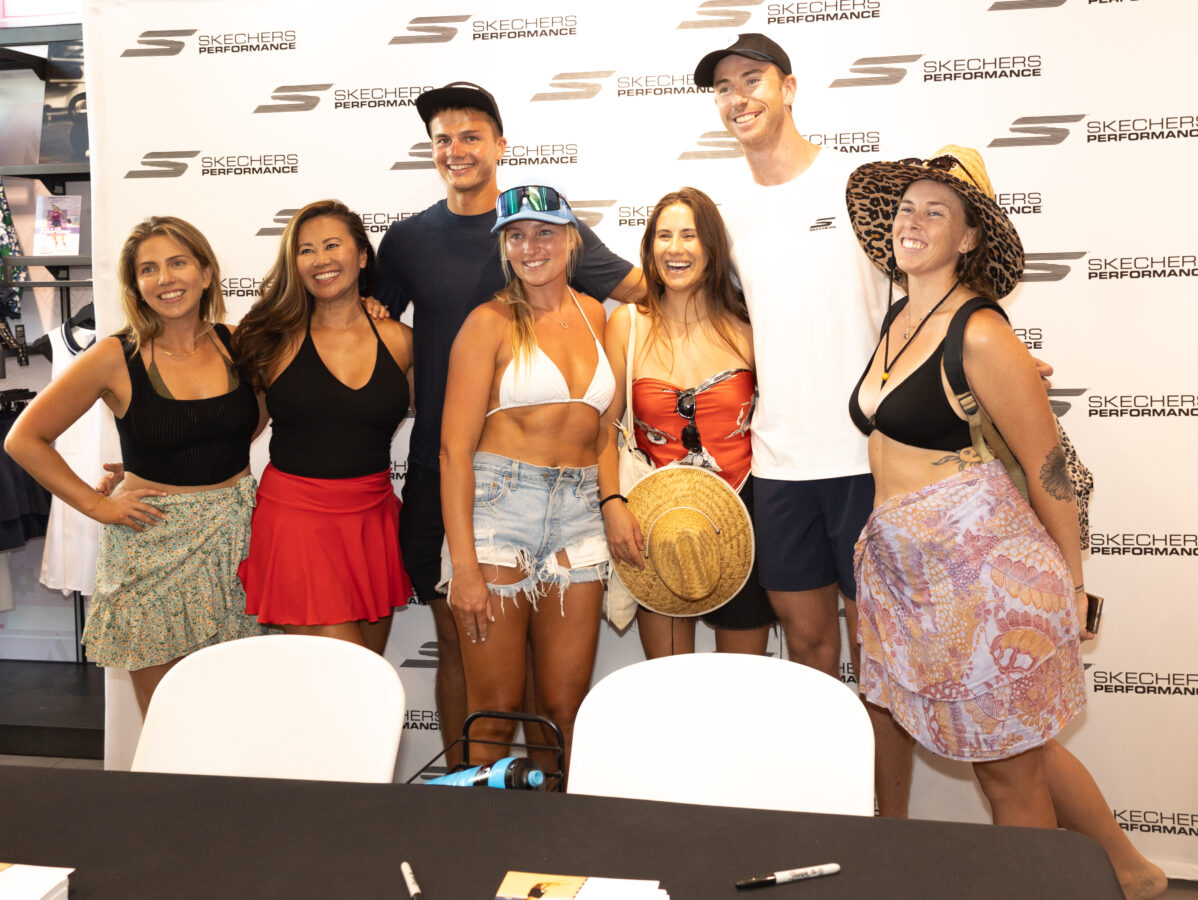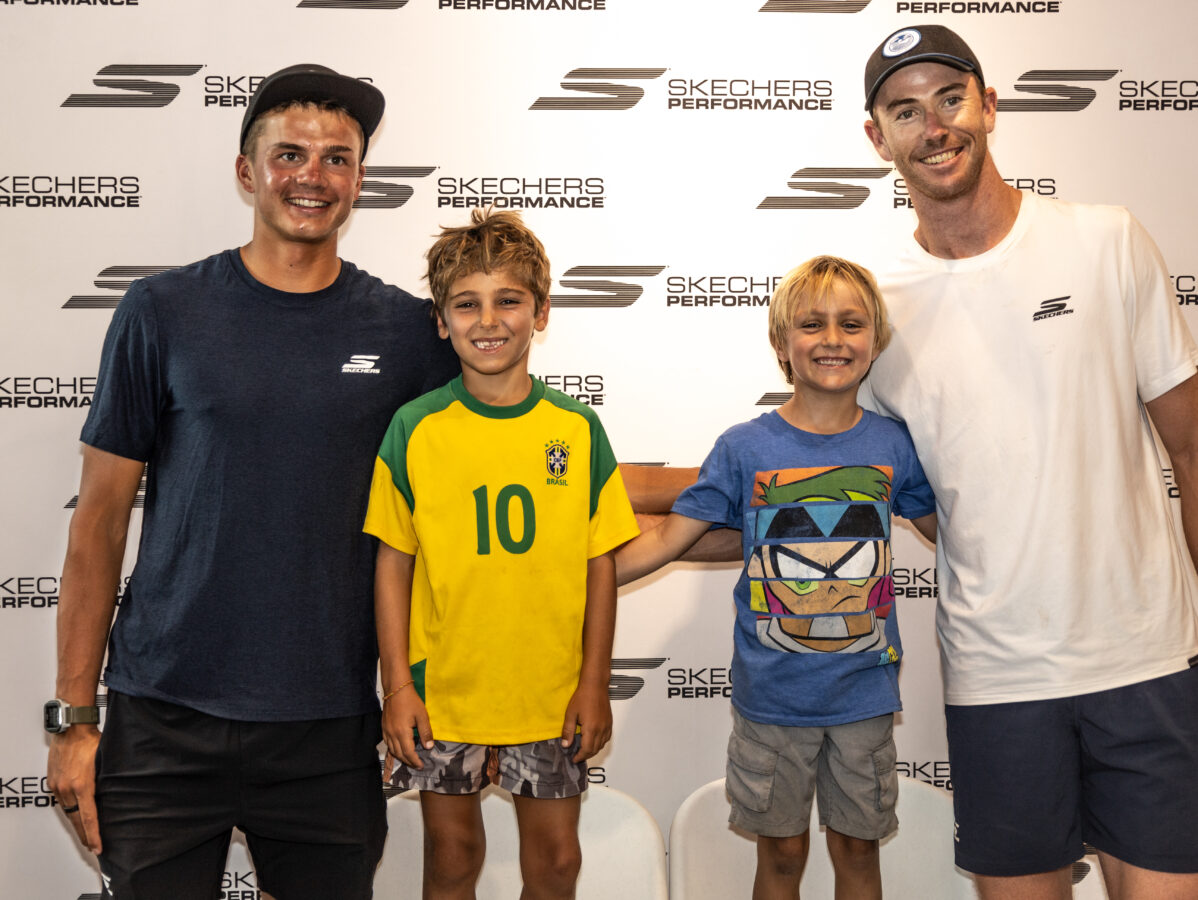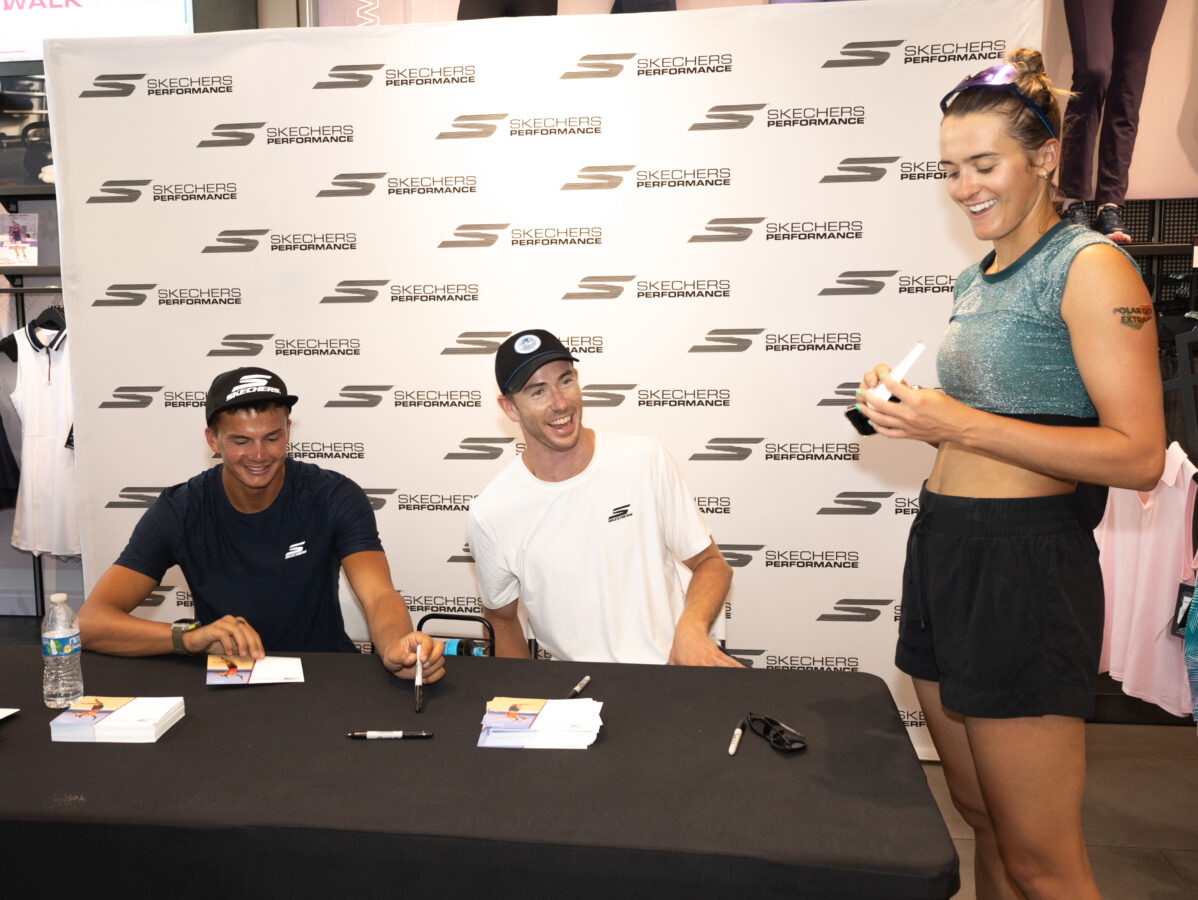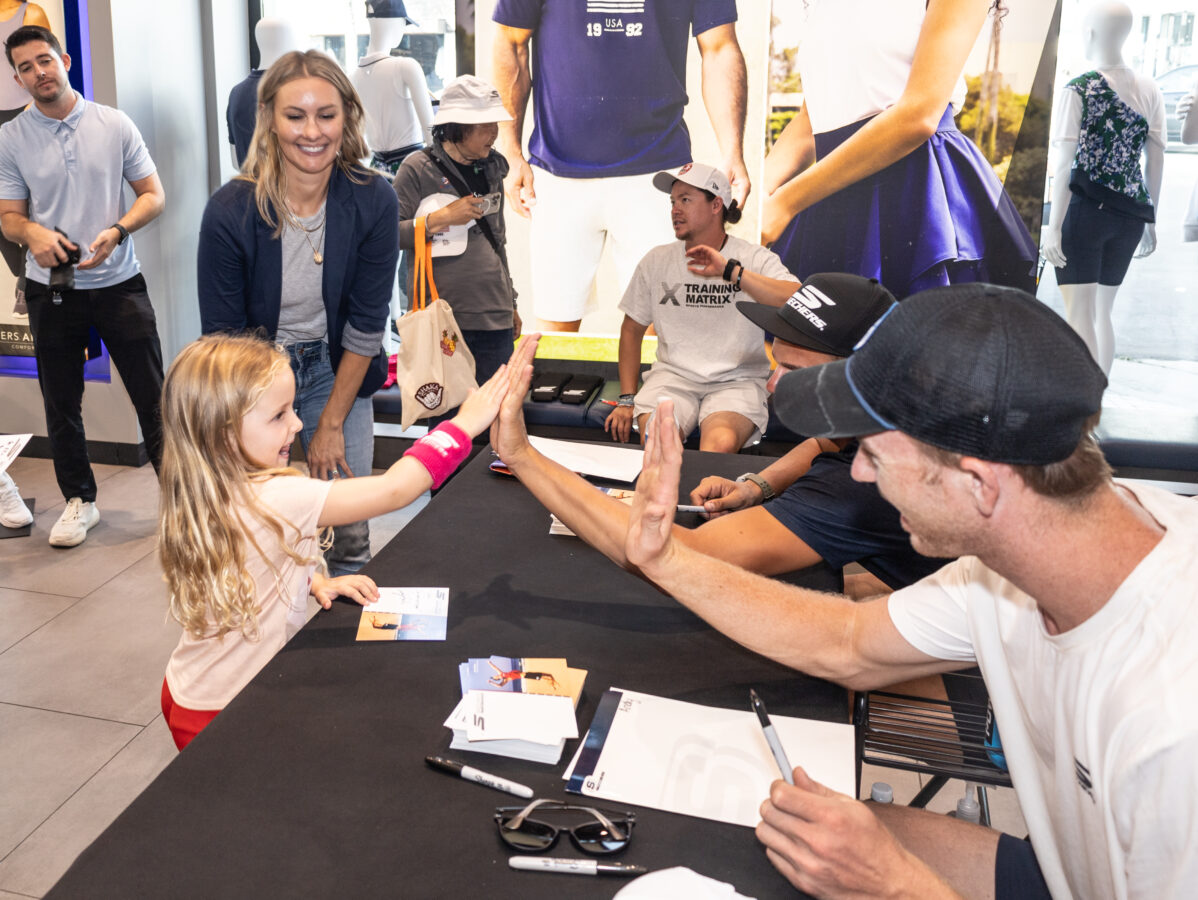by Kevin Cody
In mid-July, just two weeks before representing the U.S. in beach volleyball at the Paris Olympics, Andy Benesh and partner Miles Partain announced a sponsorship agreement with Skechers.
Manhattan Beach-based Skechers is best known for its shoes. But Skechers also manufactures apparel, ranging from moisture-wicking, SPF40 tank tops to pickleball dresses.
Athletes generally are not allowed to promote their sponsors in Olympic competition. But an exception is made for apparel sponsors. As a result Benesh’s and Partain’s competition tank tops bore their names, numbers, and, in small type, over their right shoulders, the Skechers logo.

The exposure for Skechers was significant. It has sales in 180 countries. Benesh and Partain competed in four Olympic matches televised world wide, before being eliminated in the quarterfinals. They finished an impressive fifth.
During the Manhattan Beach Open, this weekend (August 17-18), they advanced to Sunday’s finals, which were live streamed over ION TV and Bally Live. The Olympians lost in two close sets, 21-18 and 21-18, to three-time Manhattan Beach Open winner Treavor Crabb, of Redondo Beach, and partner Theo Brunner.
Friday evening, following two wins on the tournament’s opening day, Benesh and Partain signed photographs and baseball caps for fans for nearly an hour at the flagship Skechers store in downtown Manhattan Beach. The store is just a block up from the Manhattan Beach Open courts.

Following the autographing, the two discussed the financial demands of being professional volleyball players.
Sponsors like Skechers make it possible for the elite players to focus their time on training and tournaments, they said.
But most professional beach volleyball players depend on second jobs, commonly coaching, and on rent support from parents and friends in the high rent coastal communities with beaches to train on.
Fortunately, Partain pointed out, beach volleyball entry costs are low compared to most other sports. Equipment consists of a tank top, shorts and a ball, which costs $70. Unlike other sports’ venues, beach courts are free to use. Coaches commonly are paid a commission of earnings, said Benesh, who moonlighted in the financial industry early in his career.

Like most professional beach volleyball players, the two were raised in coastal communities. Benesh went to Palos Verdes High, and Partain Pacific Palisades High.
Coastal communities offer two, reinforcing benefits for beach volleyball players. Because they have beach courts, kids grow up playing the game. And because they are wealthy, they offer a pool of financial backers for promising young players.
When beach volleyball was introduced into the Olympics, in Atlanta in 1996, the men’s finals
featured four California coastal community natives. Gold was won by Karch Kiraly, of Santa Barbara, and Kent Steffes, of Pacific Palisades. Mike Dodd, of Manhattan Beach and Mike Whitmarsh, of San Diego took home the silver medal.
The Olympics boosted beach volleyball’s popularity internationally. But the player-owned domestic tour, the AVP (Association of Volleyball Professionals), continued to struggle financially. Two years after the Olympics it filed for bankruptcy.
Prior to the 2000 Olympics in Sydney, AVP lost to the FIVB (Federation Internationale de Volleyball) the authority to select the U.S. beach volleyball teams.
As a result, U.S. teams had to travel abroad to earn Olympic qualifying points on the FIVB tour. Sydney gold medalists Eric Fonoimoana, of Manhattan Beach, and partner Dain Blanton, of Laguna Beach, qualified to represent the USA just a month before the Olympics by finishing third at a FIVB tournament in Belgium.
Ironically, when the gold medalists returned from Sydney the AVP suspended them for having missed AVP tournaments.
In 2010, the AVP again filed for bankruptcy, just weeks before the 50th Anniversary of the Manhattan Beach Open, the tour’s most prestigious tournament. The 2010 MB Open was rescued by a consortium of Manhattan and Hermosa residents led by Dave Behar (founder of the ION Network, which streamed and broadcast the 2010 tournament), Manhattan Beach 6-Man director Jay Saikley, CBVA director Chris “CB” Brown, and the City of Manhattan Beach.
(In another ironic beach volleyball financial twist, ION also broadcast this past weekend’s Manhattan Beach Open. But it was the Scripps-owned ION Television, which Behar successfully sued in Federal Court over trademark infringement.)

A more positive development for beach volleyball in 2010 was its recognition as a collegiate sport by the NCAA. Today over 100 colleges have beach volleyball teams, with most offering scholarships.
Domestically, the AVP financial footing appeared to improve with its acquisition in 2021 by Bally Corp, the casino and bookmaking company, which had expanded into sports broadcasting.
In the fall Bally Sports will launch the AVP League, featuring men’s and women’s teams from eight cities — Los Angeles, San Diego, Austin, Dallas, Miami, Palm Beach, New York and Brooklyn. Bally also plans a beach volleyball fantasy league.
The inaugural AVP League tournament will be in Los Angeles on September 14 through 15. The championship will be decided at a Los Angeles tournament on November 9 and 10. Neither the venues nor the teams have been announced.
But the AVP’s financial future remains clouded by Bally Sports’ bankruptcy proceedings, filed in March 2023.
The annual AVP Hermosa Beach Open in July, another signature event, was not held this summer. But as with the Manhattan Open in 2010, a local group led by local tournament organizer and former AVP player Mark Paaluhi has stepped up to produce the Wedbush Hermosa Beach Open during the first week of September. Wedbush is a securities firm whose president, Gary Wedbush, is a Manhattan Beach resident and volleyball fan. His son Henry was the number four ranked volleyball recruit in the country in 2020, when he played for Loyola High School. This year at Princeton he was named to the All-EIVA (Eastern Intercollegiate Volleyball Assoc.) First Team.
“It’s about keeping the Hermosa Beach Open tradition alive,” Paaluhi told the Hermosa City Council when it approved the event at a May council meeting.
Despite beach volleyball’s troubled financial history, Skechers’ sponsorship of Olympians Benesh and Partain is a measure of the confidence the Fortune 500 company has in the sport’s future.

Another reason for optimism, Benesh and Partain pointed out, is that beach volleyball is no longer restricted to coastal communities. Sand courts are being built at colleges across the country, and at public parks and at private facilities.
Among the attendees at Friday’s autograph signing at Skechers was Tom Davenport, owner of Volleyball of The Rockies, in Denver Colorado. Davenport’s company has two indoor sand volleyball clubs and over 6,000 members.
Benesh played 6-man indoor volleyball at Palos Verdes High, and at USC. But he also competed in AAU Junior Beach Volleyball tournaments. He practiced on sand courts at Palos Verdes High, the first high school in the state to have them. Those courts, he said, were pivotal in his development as a beach volleyball player. ER











